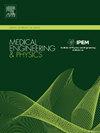A combined experimental and numerical approach to evaluate hernia mesh biomechanical stability in situ
IF 1.7
4区 医学
Q3 ENGINEERING, BIOMEDICAL
引用次数: 0
Abstract
A ventral hernia involves tissue protrusion through the abdominal wall (AW). It is a common surgical issue with high recurrence rates. Primary stability of hernia meshes is essential to guarantee mesh integration, yet existing meshes often fail to match the AW's complex biomechanics. This study proposes a novel method aiming at understanding post-operative mesh-AW interactions. Three fresh frozen human specimens underwent an open Rives-Stoppa implantation of a synthetic hernia mesh coated with metallic micro-beads. Additional beads were placed into the AW muscle tissue. CT scans were conducted at increasing levels of intra-abdominal pressure to reproduce forced breathing. Beads 3D coordinates were exported from the CT-scans and motion and strain of both the hernia mesh and the AW were calculated. At 30 mmHg, the mesh-muscle motion (or sliding) was 2.3 ± 1.3 mm. Muscle exhibited significantly higher strains (12.9 ± 4.7 %) than the hernia mesh (4.7 ± 1.1 %), most likely due to difference in material properties between the mesh and the AW. A repeatability study was carried out to build confidence in the proposed method. This protocol can bring insights of the hernia mesh use-conditions to improve hernia mesh design requirements and develop safer implants to reduce hernia recurrence.
实验与数值相结合的方法评估疝补片原位生物力学稳定性
腹疝包括通过腹壁的组织突出(AW)。这是一个常见的外科问题,复发率高。疝补片的初始稳定性对于保证补片的整合至关重要,但现有补片往往不能满足腹壁复杂的生物力学特性。本研究提出了一种新的方法,旨在了解手术后网格- aw相互作用。三个新鲜的冷冻人体标本接受了开放的rivers - stoppa移植,植入了涂有金属微珠的合成疝网。在AW肌肉组织中放置额外的珠粒。在增加腹内压力水平下进行CT扫描以重现强迫呼吸。从ct扫描中导出珠子的三维坐标,计算疝网和AW的运动和应变。30 mmHg时,网肌运动(或滑动)为2.3±1.3 mm。肌肉表现出的应变(12.9±4.7%)明显高于疝补片(4.7±1.1%),这很可能是由于补片和疝补片之间的材料特性不同。进行了可重复性研究,以建立对所提出方法的信心。该方案可以深入了解疝补片的使用条件,提高疝补片的设计要求,开发更安全的植入物,减少疝复发。
本文章由计算机程序翻译,如有差异,请以英文原文为准。
求助全文
约1分钟内获得全文
求助全文
来源期刊

Medical Engineering & Physics
工程技术-工程:生物医学
CiteScore
4.30
自引率
4.50%
发文量
172
审稿时长
3.0 months
期刊介绍:
Medical Engineering & Physics provides a forum for the publication of the latest developments in biomedical engineering, and reflects the essential multidisciplinary nature of the subject. The journal publishes in-depth critical reviews, scientific papers and technical notes. Our focus encompasses the application of the basic principles of physics and engineering to the development of medical devices and technology, with the ultimate aim of producing improvements in the quality of health care.Topics covered include biomechanics, biomaterials, mechanobiology, rehabilitation engineering, biomedical signal processing and medical device development. Medical Engineering & Physics aims to keep both engineers and clinicians abreast of the latest applications of technology to health care.
 求助内容:
求助内容: 应助结果提醒方式:
应助结果提醒方式:


